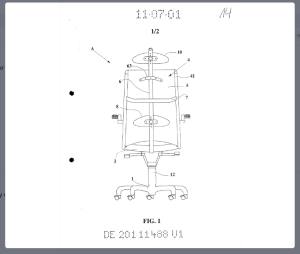An Expert Guide to Understanding Patent Claims
In the realm of intellectual property, patents serve as crucial assets for inventors, providing exclusive rights to their innovations. However, the protection offered by a patent relies greatly on the clarity and specification of its claims. In this expert guide, we delve into the intricacies of patent claims, shedding light on their significance, components, and types.
What is a Patent Claim?
At the core of a patent lies its claims, which outlines the precise scope of protection granted to the inventor by the Patent Office. Unlike the descriptive portions of a patent, such as the specification and drawings, claims are legally binding statements defining the boundaries of the invention’s intellectual property protection. They must be clear, distinct, and sufficiently detailed to provide a comprehensive understanding of the protected subject matter.
What is a Patent Drawing?
High-quality illustrations serve to depict various embodiments of the invention, offering different views or even method flow charts for clarity. Not only do these drawings provide vital support for patent claims, but they also help in fully describing the invention. It’s imperative to illustrate all examples comprehensively, considering different angles, cross-sectional views, and even hidden features if relevant. Through meticulous depiction, patent drawings enhance the understanding and strengthen the protection of the inventor’s intellectual property.

What is Included in a Patent Claim?
A patent claim typically contains an outline, which introduces the invention, followed by a set of technical features that collectively define the novelty and inventive step. These features are crucial as they distinguish the invention from existing knowledge in the field. When drafting claims, inventors must carefully consider the level of specificity required, balancing the need for precise language with the desire to maximise the scope of protection.
Patent claims can be extremely complex and detailed, mixing lawyer terminology with technical topic phrases. As a result, casual patent searchers who are not specialists in that field might overlook key claim information. With that in mind, Minesoft Origin developed a unique feature that summarises claims in an easy-to-understand manner, guaranteeing that no information is overlooked, reducing infringement, and enhancing productivity.

Why Are Patent Claims Important?
Patent claims are of crucial importance, as they serve as the cornerstone of a patent’s legal protection. They establish the boundaries within parties that are prohibited from operating without authorisation, thus safeguarding the inventor’s exclusive rights. From a legal standpoint, patent claims set the scope of legal rights after the patent is granted, which can influence your IP strategy going forward, such as the ability to license your protected IP for financial gain. Moreover, in patent infringement disputes, claims play a pivotal role in determining the extent of protection afforded to the patented invention.
The Different Kinds of Patent Claims
Patent claims can be broadly categorised into independent claims and dependent claims. Independent claims stand alone and define the invention in its entirety, whereas dependent claims reference preceding claims, further specifying, or narrowing their scope. Independent claims are typically broader, aiming to cover a range of embodiments, while dependent claims provide additional details or limitations.
Independent Patent Claims
Independent patent claims stand alone in their assertion of the invention’s novelty and scope of protection. They are comprehensive statements that include an introduction and all essential components defining the invention. Typically, the initial claim in a patent application is an independent claim, setting the foundation for the sought-after protection. These claims are intentionally broader than dependent claims, covering three distinct categories: claims for something, claims for a method of making something, and claims for a method of using something.
Dependent Claims
On the other hand, dependent patent claims complement earlier or independent claims by providing additional details or limitations. By referencing preceding claims, dependent claims narrow the scope of protection, refining it to specific scenarios or areas. They include non-essential characteristics and optional features not covered in the independent claim. This hierarchical structure allows for a better understanding of the invention’s boundaries, enhancing its legal protection while providing flexibility for variations.
Patent Claims Example
Consider a hypothetical patent for a novel type of ergonomic office chair. An independent claim might read:
- Claim 1: A chair comprising a contoured seat, an adjustable lumbar support, and a swivel base.
This claim establishes the core features of the invention, namely the ergonomic design elements that differentiate it from conventional office chairs. Subsequent dependent claims could further refine the invention by specifying additional features, such as:
- Claim 2: The chair of claim 1, wherein the contoured seat includes memory foam padding.
- Claim 3: The chair of claim 1, is further composed of armrests with adjustable height and angle.
These dependent claims serve to strengthen the protection offered by the patent, covering specific distinctions or variations of the original invention.

Gain Patent Insights to Enhance Your IP Strategy with Minesoft
Access to reliable patent search and analysis tools is indispensable in navigating the complex landscape of intellectual property. Our solutions simplify the meticulous process of patent searching and enable innovators to make better-informed decisions.
Minesoft Origin is a powerful platform that assists users looking to patent processes or methods. With its user-friendly interface and easy-to-use features, Minesoft Origin uses AI-powered technology to streamline the search for prior art and helps inventors and businesses have up-to-date information regarding patentability. Get in touch with our team of experts today to request a demo, and witness how our powerful patent search tools can benefit your business.
Conclusion
Understanding patent claims is essential for inventors seeking to protect their innovations and maximise their commercial potential. By understanding the intricacies of claim drafting and analysis, inventors can ensure robust patent protection and navigate the complexities of intellectual property law with confidence. With the right tools and expertise, businesses can harness the full potential of their intellectual assets to drive innovation and maintain a competitive edge in today’s dynamic marketplace.

